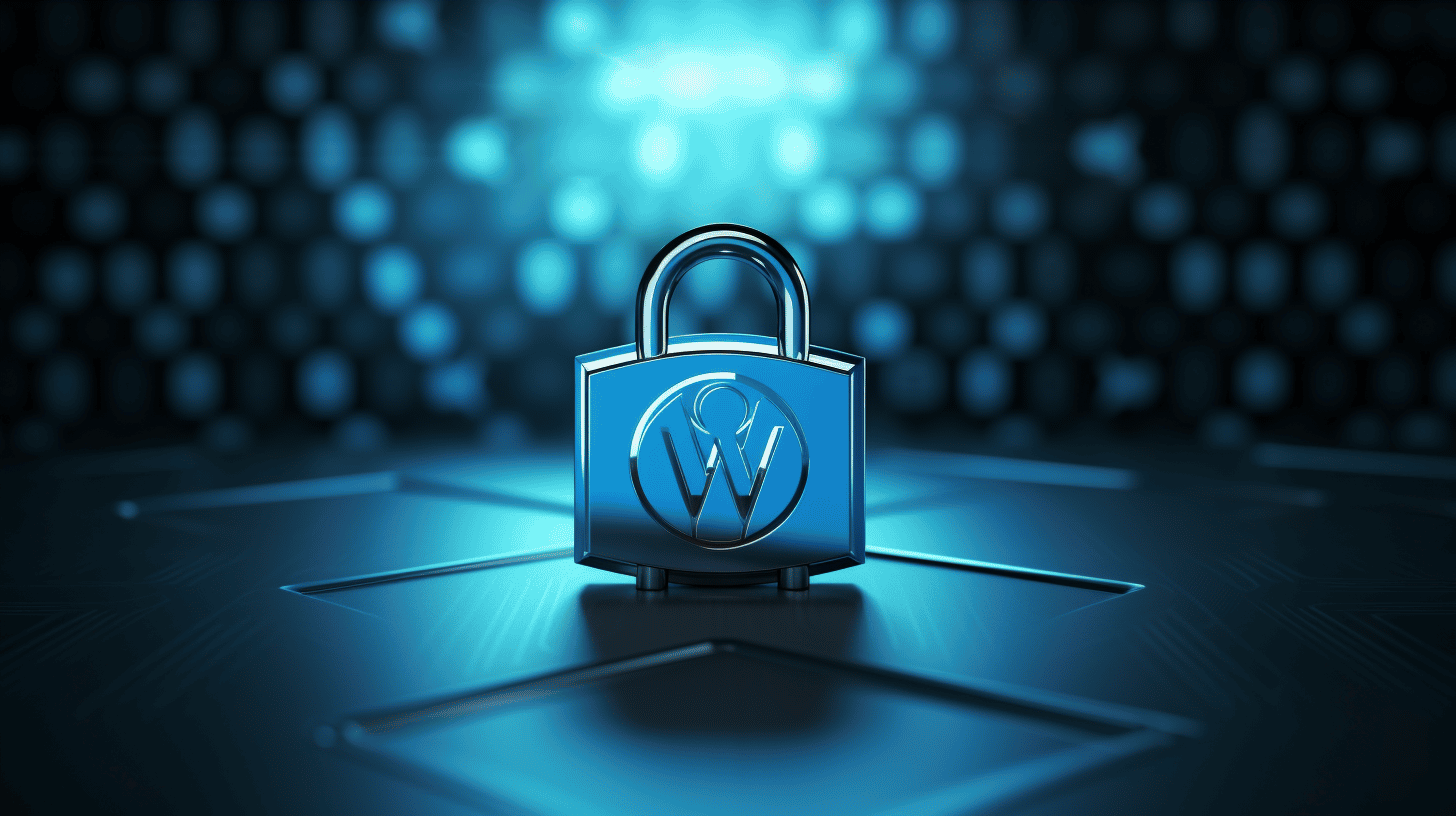在当今的数字环境中,网络安全至关重要。对于 IT 经理来说,确保网站的安全性和完整性是重中之重。企业依赖的一个流行平台是 WordPress。作为全球领先的内容管理系统 (CMS),WordPress 为互联网上超过 35% 的网站提供支持。虽然它的流行带来了许多好处,但它也使 WordPress 成为网络犯罪分子的目标。
🔐 在本文中,我们将深入探讨 WordPress 安全的世界,并为 IT 经理提供宝贵的见解和实践,以增强他们的在线形象并保护他们的网站免受潜在威胁。我们将探讨与 WordPress 安全相关的挑战、漏洞风险以及要实施的关键安全实践。
了解 WordPress 安全挑战
WordPress 是世界上最受欢迎的内容管理系统 (CMS) 之一,但它也面临安全挑战。在本节中,我们将深入探讨一些令人大开眼界的统计数据以及 WordPress 网站遭受攻击的原因,阐明优先考虑安全措施的重要性。
漏洞统计
在深入探讨 WordPress 网站遭受攻击的原因之前,让我们仔细看看与该平台相关的漏洞统计数据。这些统计数据清楚地描绘了 WordPress 用户面临的安全挑战:
- 根据 iThemes Security 的数据,2022 年报告了 1,779 个 WordPress 漏洞。到 2023 年,这一数字增加了一倍多,达到 4,833 个[1].
- 令人震惊的是,其中 26% 个漏洞仍未得到修补,导致网站面临潜在的安全漏洞[1].
- WPScan 数据库是 WordPress 漏洞的综合资源,迄今为止已发现超过 49,000 个漏洞[1].
这些统计数据凸显了实施强有力的安全措施来保护 WordPress 网站免受潜在威胁的紧迫性。
使用 WordPress 的网站比例
要了解 WordPress 安全挑战的重要性,必须了解该平台的市场份额及其在网络上的流行程度。考虑以下几点:
- WordPress 为互联网的很大一部分提供支持,所有使用该平台的网站中,有 45.8% 是惊人的[1].
- 由于如此大比例的网站运行在 WordPress 上,它成为试图利用漏洞并获得未经授权访问的恶意行为者的一个诱人目标。
这些数字提醒我们,WordPress 的流行也使其成为攻击者的主要目标。
WordPress 网站遭受攻击的原因
现在我们了解了漏洞统计数据和 WordPress 网站的普及程度,接下来,我们有必要探究针对这些网站进行针对性攻击的原因。导致 WordPress 网站遭受攻击的关键因素包括:
- 插件和主题中的漏洞:已报告的 WordPress 漏洞中约有 89% 发生在插件和主题中[1]。插件和主题提供了扩展功能和自定义选项,但如果不保持更新,它们也可能引入漏洞。
- 托管平台漏洞:相当一部分 WordPress 攻击(约 41%)可归因于托管平台上的漏洞[1]。这凸显了选择可靠且安全的托管服务提供商的重要性。
通过解决这些漏洞并采取主动措施,WordPress 用户可以显著增强其网站的安全性。
要了解有关 WordPress 相关的具体漏洞和威胁的更多信息,您可以参考 WordPress 漏洞报告。本报告提供了有关安全形势的宝贵见解,并提供了有关保护您的 WordPress 网站安全的指导。
请记住,了解围绕 WordPress 的安全挑战是采取必要预防措施保护您的网站免受潜在风险的第一步。
🔒 请继续关注下一部分,我们将讨论保护您的 WordPress 网站的关键安全最佳实践。
与 WordPress 漏洞相关的风险
凭借其用户友好的界面和丰富的插件库,WordPress 已成为世界上最受欢迎的内容管理系统 (CMS) 之一。然而,受欢迎程度往往是有代价的,而对于 WordPress 而言,代价就是网络攻击风险的增加。在本节中,我们将探讨网络攻击对 WordPress 网站的影响以及用户需要注意的潜在威胁。
网络攻击的影响
针对 WordPress 网站的网络攻击可能会对个人和企业产生深远影响。以下是这些漏洞造成如此重大风险的一些原因:
- 数据泄露:成功的网络攻击可能导致敏感用户信息泄露,例如姓名、电子邮件地址甚至付款详细信息。这不仅危及用户的隐私,还为身份盗窃和金融欺诈打开了大门。
- 网站停机时间:黑客经常利用 WordPress 中的漏洞来获取未经授权的访问并控制网站。这可能会导致网站下线或遭到破坏,从而导致收入、信誉和用户信任度的损失。
- SEO影响:遭受网络攻击的网站可能会严重损害其搜索引擎排名。谷歌等搜索引擎优先考虑用户体验和安全性。如果您的 WordPress 网站成为攻击的受害者,它可能会被标记为不安全,最终导致自然流量和潜在收入下降。
潜在威胁
网络威胁不断演变,这意味着 WordPress 用户需要主动保护他们的网站。以下是 WordPress 漏洞可能给您带来的一些潜在威胁:
- 恶意软件感染:WordPress 网站很容易感染恶意软件,这些恶意软件可能隐藏在插件、主题甚至核心 WordPress 文件中。一旦安装,恶意软件就会执行恶意活动,例如窃取数据、将流量重定向到恶意网站,甚至对其他网站发起攻击。
- 暴力攻击:暴力攻击是指黑客通过反复尝试不同的用户名和密码组合来尝试访问 WordPress 网站。如果用户的登录凭据较弱或未实施必要的安全措施,则这可能特别危险。
- 插件漏洞:虽然插件为 WordPress 网站提供了附加功能,但它们也可能带来漏洞。过时或编码不当的插件可能成为黑客的切入点,使他们能够利用漏洞并控制您的网站。
值得注意的是,没有任何 CMS 能够完全免受网络攻击。但是,了解与 WordPress 漏洞相关的风险并采取必要措施缓解这些风险,可以大大保护您的网站并确保您的在线形象。
请记住,预防是 WordPress 安全的关键。定期更新 WordPress 安装、主题和插件、实施强登录凭据以及使用安全插件只是您可以采取的几个步骤,以保护您的网站免受潜在威胁。
🔒 在数字时代,保护您的 WordPress 网站至关重要。保持警惕,保持软件更新,并主动实施强大的安全措施。通过这样做,您可以最大限度地降低与 WordPress 漏洞相关的风险并确保更安全的在线体验。
关键的 WordPress 安全实践
说到 WordPress 安全,采取主动措施对于保护您的网站免受潜在威胁至关重要。通过实施一些关键做法,您可以强化您的 WordPress 网站并保护其免受网络攻击。在本文中,我们将探讨每个 WordPress 用户应遵循的一些最重要的安全做法,以确保其网站的安全性和完整性。
定期更新
增强 WordPress 网站安全性的主要步骤之一是保持所有组件为最新。这包括更新 WordPress 核心、主题和插件。定期更新不仅会带来新功能,还会解决漏洞和安全问题。
根据一项研究,WordPress、主题和插件的版本过时是网站被入侵的最常见原因之一。通过更新您的 WordPress 网站,您可以最大限度地降低被不断寻找安全漏洞的潜在黑客利用的风险。因此,请确保:
- 定期检查 WordPress 仪表板中的更新
- 每当有新版本可用时,请更新您的 WordPress 核心、主题和插件
- 启用自动更新以确保您的网站无需人工干预即可保持受保护
使用强密码
WordPress 安全的另一个基本方面是使用强密码。弱密码和易猜密码会使您的网站容易受到暴力攻击。创建难以破解的强密码至关重要。
设置 WordPress 密码时请考虑以下提示:
- 使用大写和小写字母、数字和特殊字符的组合。
- 避免使用容易猜到的常用单词、短语或个人信息。
- 确保您的密码长度至少为 12 个字符。
- 考虑使用密码管理器来安全地生成和存储复杂的密码。
通过实施强密码实践,您可以显著降低未经授权访问您的 WordPress 网站的风险。
安装安全插件
为了增强 WordPress 网站的安全性,建议安装专用的安全插件。这些插件通过识别和解决潜在漏洞来提供额外的保护层。一些流行的安全插件包括 Patchstack、Wordfence、Sucuri 和 Malcare。
这些安全插件提供以下功能:
- 恶意软件扫描和删除
- 防火墙保护
- 预防暴力攻击
- 双重身份验证
- 登录页面定制
- 流量监控与日志分析
通过选择和安装信誉良好的安全插件,您可以加强 WordPress 网站的安全性并确保有效检测和减轻潜在威胁。
备份创建
定期备份 WordPress 网站是一项必不可少的安全措施。备份可充当安全网,让您能够在发生安全漏洞、数据丢失或其他不可预见事件时恢复网站。
请遵循以下准则来创建有效的 WordPress 备份:
- 使用可靠的备份插件来自动化备份过程。
- 选择一个安全的远程位置来存储您的备份,例如云存储服务或外部硬盘驱动器。
- 根据网站更新频率设置定期备份计划。
- 定期测试您的备份以确保在需要时可以成功恢复。
通过定期备份,您可以放心,您的网站数据是安全的,并且可以在必要时轻松恢复。
更改默认登录 URL
WordPress 网站通常使用默认登录 URL,因此很容易成为暴力攻击的目标。更改默认登录 URL 可增加一层额外的保护,使黑客更难找到登录页面。
更改默认登录 URL 的方法如下:
- 安装并激活安全插件,如 WPS Hide Login 或 Rename wp-login.php。
- 按照插件的说明配置和自定义您的新登录 URL。
通过更改默认登录 URL,您可以显著减少登录尝试次数,保护您的 WordPress 网站免受自动攻击。
适当的用户访问管理
管理用户访问对于维护 WordPress 网站的安全性至关重要。将用户权限限制为必要的权限可最大限度地降低未经授权的访问和对网站的潜在损害的风险。
请考虑以下用户访问管理的最佳实践:
- 定期审查和更新用户角色和权限。
- 删除不活跃或不必要的用户帐户。
- 对用户登录使用强身份验证方法,例如双因素身份验证。
- 限制管理员的数量并限制他们的访问权限。
- 教育您的用户有关安全登录的做法,例如避免使用公共 Wi-Fi 网络和使用 VPN 进行远程访问。
通过实施适当的用户访问管理,您可以控制谁可以访问您的 WordPress 网站并降低发生安全漏洞的可能性。
实施这些关键的 WordPress 安全实践可保护您的网站和宝贵的数据免受潜在威胁。请记住,维护安全的 WordPress 网站需要持续的意识和警惕性。及时了解最新的安全趋势,定期审核您的网站,并将安全作为首要任务。通过采取这些步骤,您可以确保您的 WordPress 网站对访问者保持安全。有关提高 WordPress 安全性的更多提示,请查看 提高 WordPress 安全性的技巧.
结论
总之,为您的 WordPress 网站实施强大的安全措施对于保护您的在线状态和宝贵数据至关重要。通过保持主动性并遵循关键的安全实践(例如定期更新、强密码和使用安全插件),您可以显著降低网络攻击的风险。
请记住,WordPress 漏洞是一个真实且持续存在的威胁,但只要采取正确的预防措施并使用 Managed-WP™ 等可靠的托管平台,您就可以增强网站的安全性并高枕无忧。Managed-WP™ 提供优质的托管 WordPress 云托管平台,可简化基础设施、提供专家支持并确保主动监控。通过选择 Managed-WP™,您可以专注于您的业务,而将技术方面的问题留给专家。
立即使用 Managed-WP™ 保护您的 WordPress 网站并增强您的在线形象。了解有关我们服务的更多信息 在这里,。💪🔒
常见问题
- 为什么 WordPress 安全性对 IT 经理很重要?
WordPress 安全性对于 IT 经理来说至关重要,因为它有助于保护敏感数据、防止未经授权的访问和数据泄露、维护组织的声誉并防止潜在的法律责任。
- 一些常见的 WordPress 安全漏洞有哪些?
一些常见的 WordPress 安全漏洞包括弱密码、过时的插件和主题、不安全的托管环境、缺乏定期更新和补丁以及用户权限不足。
- IT 经理可以实施哪些安全措施来加强 WordPress 的安全性?
IT 经理可以实施各种安全措施,例如使用强大而独特的密码、保持插件和主题更新、使用安全托管服务提供商、启用双因素身份验证 (2FA)、实施 Web 应用程序防火墙 (WAF) 以及定期执行安全审核。
- 有没有 IT 经理可以使用的 WordPress 安全插件?
是的,IT 经理可以使用多种 WordPress 安全插件来增强网站安全性。一些流行的选项包括 Wordfence Security、Sucuri Security、iThemes Security 和 All In One WP Security & Firewall。
- 如果出现 WordPress 安全漏洞,IT 经理应采取什么措施?
如果发生 WordPress 安全漏洞,IT 经理应立即隔离受影响的环境、更改所有密码、进行备份以供进一步分析、调查漏洞以确定原因、从干净的备份恢复网站,并实施额外的安全措施以防止将来发生漏洞。



















